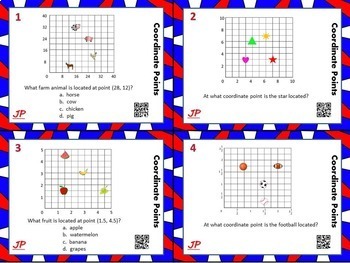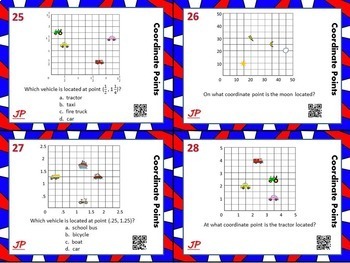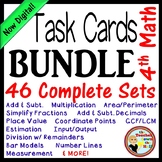COORDINATE PAIRS Coordinate Point TASK CARDS NOW Digital!
- PDF
- Easel Activity
Also included in
- Need some fun ways to review coordinate points? This bundle is full of fun ways to practice locating coordinate points. Ordered Pairs include whole numbers, fractions and decimals. Bingo w/ 35 Bingo cards for a fun whole group review, Task Cards with QR Codes for independent or group practice, andPrice $7.90Original Price $11.35Save $3.45
- **NOW ALL SETS FORMATTED FOR YOUR DISTANCE LEARNING NEEDS!**Need an independent way for students to master math objectives? Each of the 49 Sets of Task Cards include 24-28 cards and come with a student response sheet and an answer key. All are in color and include many different visuals. All alsoPrice $90.00Original Price $117.65Save $27.65
- **ALL SETS NOW FORMATTED FOR YOUR DISTANCE LEARNING NEEDS!**Need an independent way for students to master math objectives? Each Set of Task Cards include 24-28 cards and come with a student response sheet and an answer key. All are in color and include many different visuals. All also include QR CPrice $75.00Original Price $108.10Save $33.10
Description
**NOW FORMATTED FOR YOUR DISTANCE LEARNING NEEDS!**
Need a fun and independent way for students to practice finding coordinate points? Each of the 28 cards has a coordinate grid with missing x and y axis labels. Students will have to determine the increments for each grid, then locate one of the four items shown on each.
Two types of questions:
At what point is the _____ located?,
and Which _____ can be found at point (1 1/2, 4)?
Grids are measured in units, 2's, 3's, 4's, 5's, 10's, .5's, .25's, 1/2, and 1/4.
The cards can be used as Task Cards with the QR Codes, or pass around the room and have students complete the included answer sheet.
Either way, this is a great review for Coordinate Points.
*****************************************************************************
Other great resources
Multiple Meaning Words Vocabulary Cards
*****************************************************************************
Customer Tips:
How to get TPT credit to use on future purchases:
• Please go to your My Purchases page (you may need to login). Beside each purchase you'll see a Provide Feedback button. Simply click it and you will be taken to a page where you can give a quick rating and leave a short comment for the product. Each time you give feedback, TPT gives you feedback credits that you use to lower the cost of your future purchases. I value your feedback greatly as it helps me determine which products are most valuable for your classroom so I can create more for you.
Be the first to know about my new discounts, freebies and product launches:
• Look for the green star next to my store logo and click it to become a follower. Voila! You will now receive email updates about this store.
**********************************************************************









